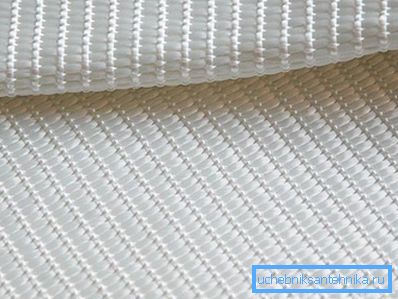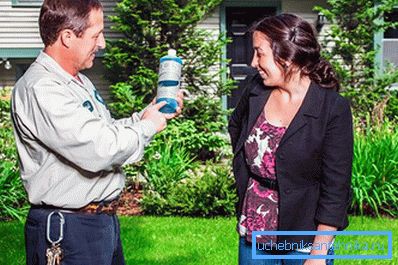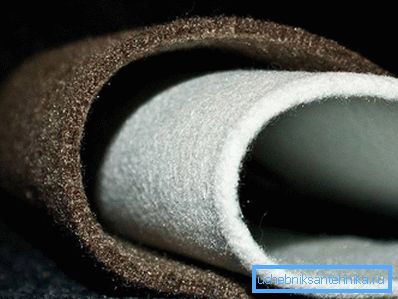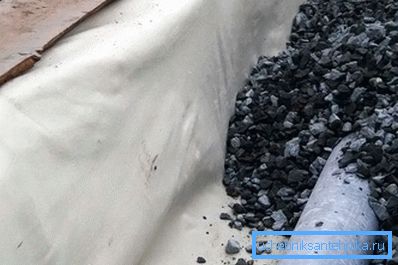Drainage geotextiles
Drainage systems, especially those laid in depth, need additional protection. The fact is that the water that seeps into the sod brings with it small particles. Gradually, all this garbage accumulates and the silting of the holes and the filtering layer occurs. As a result of this process, the effectiveness of the drainage system is reduced. To prevent silting, it is advisable to wrap the filtering layer (a layer of gravel or rubble) with geotextile. This material appeared not so long ago, but it has already become quite popular.
Geotextile properties

Most manufacturers offer geotextiles made from:
- Polypropylene or polyester. This is the highest quality material, but the price for it will be appropriate;
- Staple raw material or monofilament. Such geotextiles are not much inferior to the first option in quality and properties, but it costs a bit cheaper;
- The mixed thread is the most inexpensive material. It is made from waste textile production. To use such geotextiles for drainage is impractical. The fact is that in its composition there may be natural fabrics that quickly rot in the soil.

For drainage works choose material from synthetic fabrics. Such a canvas will differ in the following positive qualities:
- Resistance to various adverse effects. Chemically active environments, mold and dampness are not terrible. Due to this, the web will longer protect your drainage system from silting;
- Since the canvas is made of synthetic fabrics, it is inedible for rodents and various insects. Mice and moles will not be able to make holes in it, and therefore break the protective layer;
- Despite the unnatural raw materials used, such geotextiles are environmentally friendly materials. Placing it in the ground, you can not be afraid for the harvest in the beds, even if they are located in the immediate vicinity of the drainage system;
- The canvas is able to withstand large temperature differences. Geotextiles do not change their properties in the range from -60 to +110? C. This feature allows the use of such material in virtually every region of our country;
- This canvas is very durable and elastic.
In addition, geotextiles are fabrics, which means that this material is lightweight. This canvas is easy to lay, cut and fold as you need.
Selection features

First of all, it is worth paying attention to what the drainage geotextile is made of. If it contains natural fabrics, then it is absolutely impossible to use such a canvas. Geotextiles with natural impurities will fail, not having served even a year. For drainage systems, as we said above, you only need to choose a synthetic fabric.
The next thing you should pay attention to when making a choice is the manufacturing technology. There may be two options:
- Thermal bonding technology. With this method, the threads of the raw material are heated to certain temperatures, as a result, they are soldered, creating a solid canvas. Such a geotextile is very durable. Thermobonded cloth is most often used for drainage of the foundation and other similar systems. Especially the use of geotextiles is necessary if gravel or crushed stone is used as a filter layer;
- Needle punch technology. This method involves flashing the main layer of fibers with additional threads. The result is a high-quality canvas, but slightly inferior in strength to the first option. Needle-punched geotextiles are more suitable for drainage systems using geocomposite mats.
But the most important parameter to which attention should be paid when making a choice is the density of the material. From this property will depend on the ability to retain water, reinforcing characteristics and protection performance.
Tip! Manufacturers produce geotextiles of various densities. There are models with this indicator lying in the range from 100 to 800 grams. on m2. So there is always a choice.
And what kind of canvas suitable for drainage systems? In this matter, the opinions of many experts differ. It is believed that the denser the material, the stronger it is and has greater protective functions and a long service life. But at the same time a more dense canvas and is more expensive.

As practice shows, the cheapest version of geotextiles with a density of 100 grams. on m2 poorly suited for drainage works. This canvas is not strong enough and quickly fails. Loose geotextiles are most often used in landscape design.
When creating a drainage experts recommend using a cloth with a density of 200 grams. on m2. Such material has sufficient strength, permeability and durability. Geotextiles of such density are most often used in “simple” areas. If the soil is fragile or there is a danger of a landslide, then it is better to use a canvas of 300 grams. on m2. In this case, your drainage system will not threaten anything.
Tip! WITHto pay attention to the brand of the material. There are many manufacturers in the market today. In the shops you can find paintings of Russian, Czech, German and American production. Some companies are well known, others are not known to anyone. In order not to spend money in vain, you can visit an online forum or a portal with the appropriate topics.
Recommendations for use

In order for the acquired geotextiles to fully perform their functions, it is not enough to choose it correctly, it is necessary and to lay it in compliance with all the rules. When arranging the drainage system, the following recommendations of specialists should be used:
- Preparing a trench it is necessary to level its bottom and walls. The presence of construction debris or other objects with sharp edges;
- Find out in advance how a purchased geotextile tolerates exposure to sunlight. Some brands are “afraid” of ultraviolet, therefore, it is necessary to unpack the canvas immediately before laying in the ground. To reduce exposure to direct sunlight, geotextiles can be contaminated;
- It is not necessary to leave a piece of geotextile damaged when laying in the ground. Even a small hole can reduce the efficiency of the entire system over time;
- When laying do not need to stretch the canvas - it should lie free.
After filling the filtering layer and laying the turf, the canvas is wrapped so that an overlap of at least 0.3 meters is obtained. Moreover, if the ground can precipitate, then the overlap can be more (up to 0.6 m).